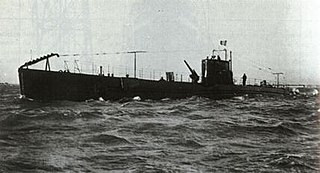The Glauco class was a pair of submarines ordered by the Portuguese government, but were taken over and completed for the Regia Marina during the 1930s. They played a minor role in the Spanish Civil War of 1936–1939 supporting the Spanish Nationalists.

Delfino was one of four Squalo-class submarines built for the Regia Marina during the late 1920s. The boat served in World War II and was sunk in 1943 after a collision with another Italian ship.

The Argonauta-class submarine was the first sub-class of the 600 Series of coastal submarines built for the Regia Marina during the 1930s. Some of these boats played a minor role in the Spanish Civil War of 1936–1939 supporting the Spanish Nationalists. Of the seven boats built in this class, only a single one survived the Second World War.
Glauco was the lead ship of her class of two submarines ordered by the Portuguese government, but taken over and completed for the Regia Marina during the 1930s.
Otraria was one of two Argo-class submarines ordered by the Portuguese government, but taken over and completed for the Regia Marina during the 1930s. She played a minor role in the Spanish Civil War of 1936–1939 supporting the Spanish Nationalists.
Argo was the lead ship of her class of two submarines ordered by the Portuguese government, but taken over and completed for the Regia Marina during the 1930s.
Velella was one of a pair of submarines ordered by the Portuguese government, but taken over and completed for the Regia Marina during the 1930s.
Anfitrite was one of a dozen Sirena-class submarines, the second sub-class of the 600 Series of coastal submarines built for the Regia Marina during the early 1930s.
Naiade was one of a dozen Sirena-class submarines, the second sub-class of the 600 Series of coastal submarines built for the Regia Marina during the early 1930s.
Argonauta was the lead ship of her class of seven submarines built for the Regia Marina during the early 1930s.
Fisalia was one of seven Argonauta-class submarines built for the Regia Marina during the early 1930s.
Jalea was one of seven Argonauta-class submarines built for the Regia Marina during the early 1930s. She played a minor role in the Spanish Civil War of 1936–1939 supporting the Spanish Nationalists.
Jantina was one of seven Argonauta-class submarines built for the Regia Marina during the early 1930s. She played a minor role in the Spanish Civil War of 1936–1939 supporting the Spanish Nationalists, and was later sunk during World War II.
Medusa was one of seven Argonauta-class submarines built for the Regia Marina during the early 1930s.
Salpa was one of seven Argonauta-class submarines built for the Regia Marina during the early 1930s.
Serpente was one of seven Argonauta-class submarines built for the Regia Marina during the early 1930s.

Narvalo was one of four Squalo-class submarines built for the Regia Marina during the late 1920s. The boat served in World War II and was sunk in 1943 by British destroyers and aircraft.

Squalo was the lead ship of her class of four submarines built for the Regia Marina during the late 1920s. The boat served in World War II and was decommissioned in 1948.

Tricheco was one of four Squalo-class submarines built for the Regia Marina during the late 1920s. The boat served in World War II and was sunk in 1942 by the British submarine HMS Upholder.
The Bragadin-class submarines were built for the Regia Marina during the late 1920s. Both boats participated in the Second World War and were discarded in 1948.


